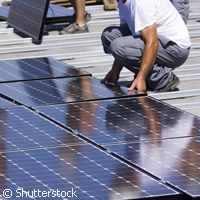Photovoltaic power grows in EU
Is photovoltaic (PV)-generated electricity taking the world by storm? Latest figures released by the European Commission's Joint Research Centre (JRC) point to a steady, growing trend in this green energy area. Newly installed PV cells generated 7.4 gigawatts (GW) of power globally in 2009, of which 5.8 GW were produced in Europe, says the JRC its 9th annual Photovoltaics Status Report, released on 6 September. The EU covered 75% of PV cells installed in 2009. According to the study, conducted by the JRC's Institute for Energy (IE), cumulative installed PV power production capacity (both new and existing) stood at 16 GW by 31 December, representing around 70% of the 22 GW global capacity. A breakdown shows that around a quarter of a million households in Europe can be powered with just 1 GW for 1 year. Of the 27.5 GW new power capacity developed in 2009 alone, more than 20% was based on PV power. The figure rose by 0.7 GW to 5.8 GW on the year. The market reporting the biggest growth was Germany's with 3.8 GW. In fact, around 2.3 GW were connected to the grid from October to December. Italy ranked second with 0.73 GW, followed by Japan (0.48 GW), the US (0.46 GW), the Czech Republic (0.41 GW) and Belgium (0.3 GW). Germany also tops the global list for cumulative installed capacity (9.8 GW), followed by Spain (3.5 GW). Renewable energy legislation in these countries has helped raise these figures. However, the budding PV market has room to grow despite these latest figures. PV accounted for 0.4% of total supplied electricity in the EU in 2009, representing just 0.1% on the world arena. The JRC report estimates that global PV cells production swelled by 56% to 11.5 GW year-on-year, and by 0.1% to 2 GW in the EU. The world leaders for 2009 were China (4.4 GW), followed by Taiwan (1.6 GW) and Malaysia (0.72 GW). Meanwhile, although some businesses decided to either condense or cancel their plans to expand PV production on a global scale in 2008 and 2009, new players, such as power-related enterprises, entered the scene and gave the industry a boost, effectively offsetting any potential losses. The JRC report also points out that market changes, moving from 'a supply to a demand-driven logic, and the resulting over capacity for solar modules' triggered a sharp price drop of around 50% over a 2-year period. Each watt was sold for around EUR 1.5. On the technology front, the JRC notes that water-based silicon grabbed the lion's share of the market in 2009, clinching a whopping 80%. Thin-film solar products increased their market share to 16%-20% in the same year. 'The existing PV technology mix is a solid foundation for future growth of the sector, as no single technology can satisfy all the different consumer needs,' the JRC says. 'The variety of PV technologies is an insurance against a "roadblock" for the implementation of solar PV electricity if material limitations or technical obstacles restrict the further development or growth of a single technology pathway.' The data, compiled from over 300 enterprises on the international markets, focused especially on the EU market, as well as China, India, Japan, Taiwan and the US. The study also provides insight into what is currently happening in this sector in terms of research, manufacturing and bringing PV power to market. It should be noted that due to the difficult market situation, along with fewer enterprises wanting to report confidential data, the data for 2009 may have a higher uncertainty compared with previous years, the JRC says.
Countries
Belgium, China, Czechia, Germany, Spain, Italy, Japan, Malaysia, Taiwan, United States



